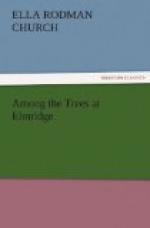QUEER RELATIONS: THE CAOUTCHOUC AND THE MILK TREE.
“What dark, strange-looking trees!” exclaimed the children while looking at an illustration of caoutchouc trees in Brazil. “How thick and strong they are! And what funny tops!—like pointed umbrellas.”
“The India-rubber tree is not likely to be mistaken for any other,” said their governess, “and it does not look very dark and gloomy in that forest, where everything seems to be crowded close and in a tangle, because South American vegetation grows so thickly and rapidly. This is the country which supplies the largest quantity of India-rubber. Immense cargoes are shipped from the town of Para, on the river Amazon, and obtained from the Siphonia elastica.”
“Are the stems all made of India-rubber?” asked Edith, who thought that was exactly what they looked like.
“Are the stems of the maple trees made of maple-sugar?” replied Miss Harson. “The India-rubber is got from its tree as the sugar is from the maple tree. It is taken from the trunk in the shape of a very thick milky fluid, and it is said that no other vital fluid, whether in animal or in plant, contains so much solid material within it; and it is a matter of surprise that the sap, thus encumbered, can circulate through all the delicate vessels of the tree. Tropical heat is required to form the caoutchouc; for when the tree is cultivated in hothouses, the substance of the sap is quite different. The full-grown trees are very handsome, with round column-like trunks about sixty feet high, and the crown of foliage is said to resemble that of the ash.”
“Did people always know about India-rubber?” asked Clara.
“No indeed! It is not more than a hundred and fifty years—perhaps not so long—since it was a great curiosity; so that a piece half an inch square would sell in London for nearly a dollar of our money, but now it comes in shiploads, and a pound of it costs less than quarter of that sum. It is used for so many purposes that it seems as if the world could never have gone on without it. All sorts of outside garments to keep out the rain are made of it. Waterproof cloaks are called macintoshes in England because this was the name of the person who invented them. India-rubber is also used for tents and many other things, and, as water cannot get through it, there is a great saving of trouble and expense.”
“It must be splendid for tents,” said Malcolm; “no one need care, when snug under cover, whether or not it rained in the woods.”
“People do care, though,” was the reply, “for they expect, when in the woods, to live out of doors; but the India-rubber is certainly a great improvement on tents that get soaked through.”
“I like it,” said Edith, “because it rubs things out. When I draw a house and it’s all wrong, my piece of India-rubber will take it away, and then I can make another one on the paper.”
“That is the very smallest of its uses,” replied Miss Harson, smiling at the little girl’s earnestness, “and yet we find it a great convenience. An English writer, speaking of it when it was first known in England, said that he had seen a substance that would efface from paper the marks of a black-lead pencil, and he thought it must be of use to those who practiced drawing.”




